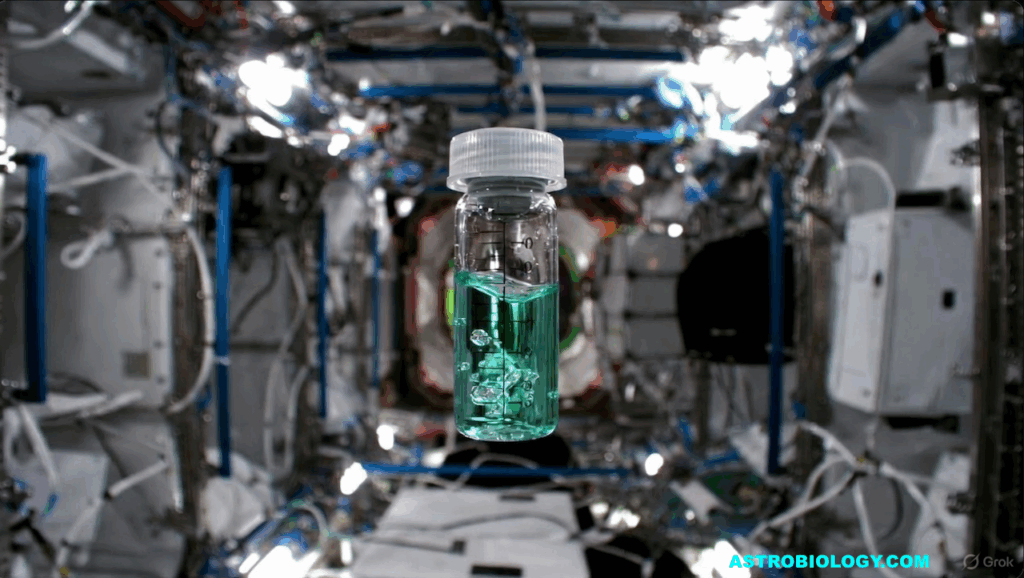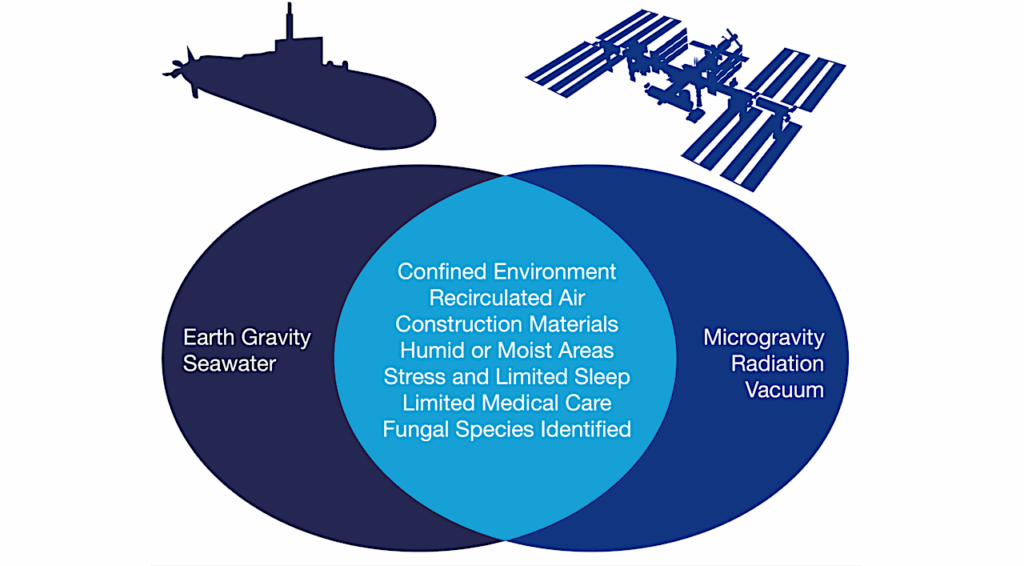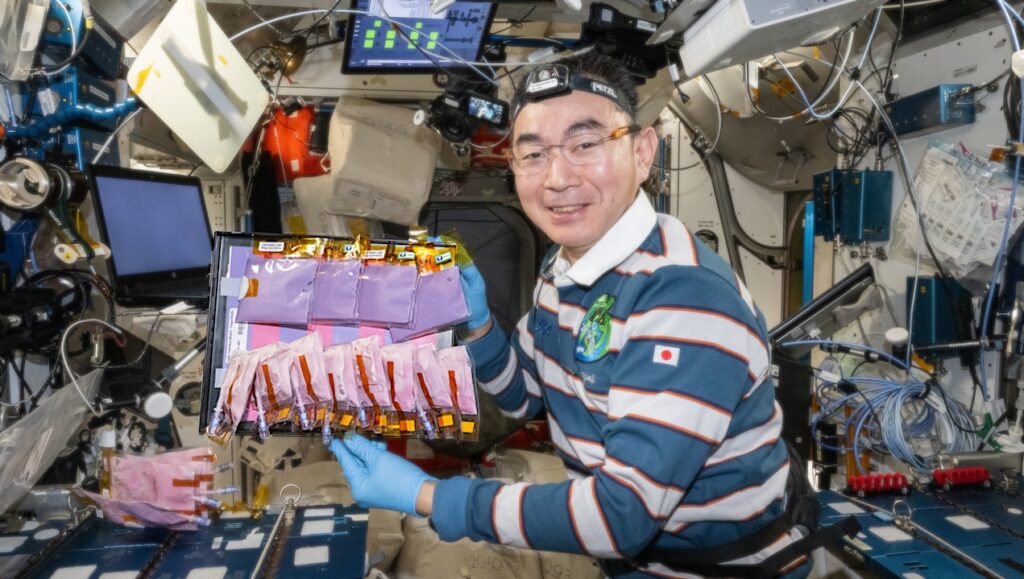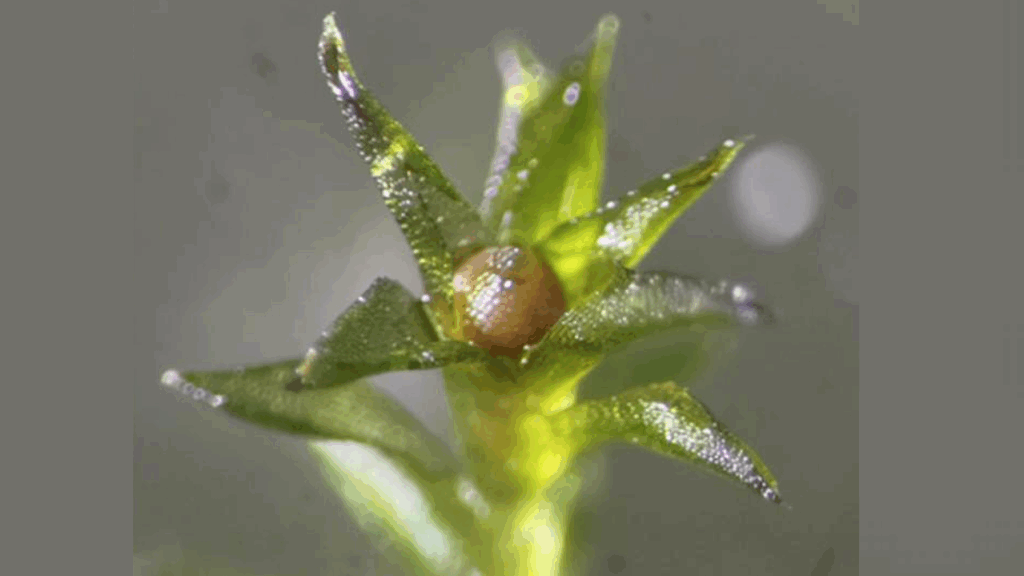NASA Spaceline Current Awareness List #1,178 12 December 2025 (Space Life Science Research Results)

NASA Spaceline Current Awareness — Grok via Astrobiology.com
The abstract in PubMed or at the publisher’s site is linked when available and will open in a new window.
Papers deriving from NASA support:
- Chino Y, Olson JD, Aichele S, Bailey SM, Schaaf GW, Cline JM, Johnson TE.The impact of dose, sex, and age at time of acute whole-body radiation exposure on long-term hematopoiesis in rhesus macaques (Macaca mulatta).Radiat Res. 2025 Oct 1;204(4):408-20.PI: S.M. BaileyNote: From the abstract: “In this study, archival data from the non-human primate radiation late effects cohort was analyzed to evaluate long-term effects on the hemopoietic system.”
Journal Impact Factor: 2.7
Funding: NASA grant #80NSSC19K0434 funding. - Anderson SR, Jorge MN, Bell ST.Identifying cognitive capabilities required for optimal surface extravehicular activity performance.npj Microgravity. 2025 Dec 6.Note: From the abstract: “Surface extravehicular activity (EVA) is one of the most cognitively demanding actions that astronauts can execute. Decrements in cognitive performance present an important risk to crew safety, yet there is currently insufficient data to characterize the cognitive capabilities required for optimal surface EVA performance. Here, we conducted a cognitive task analysis with 15 astronauts and subject matter experts to characterize the cognitive demands of surface EVA tasks and to identify the risks associated with decrements in cognitive performance during surface EVA.” This article may be obtained online without charge.
Journal Impact Factor: 5.1
Funding: “Research was funded by NASA’s Mars Campaign Office (MCO) in research projects to the Behavioral Health & Performance Laboratory. SA and MJ were supported by KBR’s Human Health and Performance Contract NNJ15HK11B through NASA.” - Ryder VE.Revisions to spacecraft maximum allowable concentrations for 2-butanone.Aerosp Med Hum Perform. 2025 Dec 1;96(12):1094-7. Review.Note: From the abstract: “At high concentrations 2-butanone is an irritant that may cause central nervous system effects. In 1996, NASA established spacecraft maximum allowable concentrations (SMACs) for short-duration, off-nominal scenarios at 50 ppm based on human exposure data from the 1940s. Limits for 7, 30, and 180 d were set at 10 ppm using the same data, but accounting for the small number of volunteers and extrapolation from mild effects to no effects for nominal operations. Limits were not established for missions of 1000 d.”
Journal Impact Factor: 0.9
Funding: V.E. Ryder is affiliated with NASA Johnson Space Center. - González AL, Merder J, Andraczek K, Brose U, Filipiak M, Harpole WS, Hillebrand H, Jackson MC, Jochum M, Leroux SJ, Nessel MP, Onstein RE, Paseka R, Perry GLW, Peace A, Rugenski A, Sitters J, Sperfeld E, Striebel M, Zandona E, Mozsár A, Bluhm S, Doi H, Eisenhauer N, Farjalla VF, Hood J, Kratina P, Lovelock C, Moody EK, Pollierer ME, Potapov A, Romero GQ, Roussel JM, Scheu S, Scheunemann N, Seeber J, Steinwandter M, Susanti WI, Tiunov A, Dézerald O.Nitrogen deposition reveals global patterns in plant and animal stoichiometry.Nat Commun. 2025 Dec 9;16:10977.Note: This article may be obtained online without charge.
Journal Impact Factor: 15.7
Funding: R. Paseka is affiliated with NASA Headquarters. - Langwig MV, Sneed SL, Rasmussen A, Seitz KW, Lee JA, Anantharaman K, De Anda V, Francis CA, Baker BJ.Metabolic capacity is maintained despite shifts in microbial diversity in estuary sediments.ISME Commun. 2025 Oct 11;5(1):ycaf182.Note: This article may be obtained online without charge.
Journal Impact Factor: 6.1
Funding: J.A. Lee is affiliated with NASA Ames Research Center.
Other papers of interest:
- Coelho LF, Miranda C, Canas J, Morgado M, Nunes D, Henriques AF, Langeveld AB.One giant leap for womankind: First menstrual cups tested in spaceflight conditions.npj Women’s Health. 2025 Dec 2;3:64.Note: This article may be obtained online without charge.
- Mastrandrea CJ, Rabineau J, Greaves D, Hughson RL.Bio-monitor detects reduced obstructive sleep apnea and susceptibility to arrhythmia in spaceflight.Aerosp Med Hum Perform. 2025 Dec 1;96(12):1084-9.Note: This article is a Case Report.
- Parveen A, Vassilieva G, Popova Y, Fomina E, Savinkina A, Platat C.Effects of an 8-month isolation on body composition and cardiopulmonary exercise testing: SIRIUS-21 space analog mission.Acta Astronaut. 2026 Feb 26;239:949-61.
- Mari M, Martinez-Vicente M.Autophagy beyond Earth: Dr. Ghada Alsaleh on aging, cells, and space.Autophagy. 2025 Dec 10. Online ahead of print.
- Schlaff CD, Ghenbot S, Fredericks DR, Jr., Pisano AJ, Helgeson MD, Wagner SC.Pathophysiological spine adaptations and countermeasures for prolonged spaceflight: Part II-space radiation.Clin Spine Surg. 2025 Nov 18. Online ahead of print.
- Azarkin MY, Terkulov AR, Tolochek RV, Shurshakov VA.[Simulation of an additional protection against ionizing space radiation in orbital missions.]Aerosp Med Hum Perform. 2025;59(6):89-95. Russian.
- Levinskikh MA.[Plants as model objects of research in space biology. Part 1. (Arabidopsis thaliana (L.) HEYNH).]Aerosp Med Hum Perform. 2025;59(6):12-22. Russian.
- Sokol M, Holuša J, Volf P, Buršík D, Matějka M, Adameková K, Uxa T, Luzzatto-Knaan T, Szymszová S, Leová L, Lin Y-J, Hsu W-C, Huang K-L, Hejda J, Kutílek P.Antarctic expedition at J.G. Mendel Station: An operational and scientific overview and its potential as a space analog environment.Acta Astronaut. 2026 Feb;239:239-55.Note: From the abstract: “Terrestrial analog environments are critical for preparing for long-duration space exploration by simulating the isolated, confined, and extreme conditions of off-world habitats. This paper presents an operational and scientific overview of the 2025 austral summer expedition to the Johann Gregor Mendel Czech Antarctic Station on James Ross Island, documenting its potential as a high-fidelity space analog.”
- Tommila CD, de Weck OL, Claypool IR.Measures of operational utility in evolving space situational awareness sensor networks.Acta Astronaut. 2026 Feb;239:1-13.Note: From the abstract: “There is a growing need for the evolution of legacy space situational awareness (SSA) sensor architectures to enable effective Space Traffic Management (STM) in today’s orbital environment. The marginal utilities of data produced by these sensors are driven by the sensitivity of operational decisions to their availability and accuracy. However, few metrics of operational utility exist to inform future SSA system architecture efforts. This work demonstrates the sensitivity of traditional system performance metrics to operational context and identifies measures of STM-specific utility which may be used to inform the design of SSA sensor networks.”
- Xu Y, Ding Y, Pei W, Zhang M, Wang X, Zeng Q, Hei TK, Hu W, Zhou G.The role and mechanism of ARRB1 in simulated space radiation and microgravity-induced lung carcinogenesis.npj Microgravity. 2025 Dec 3. Online ahead of print.Note: This article may be obtained online without charge.
- Golubkova MA, Ogneva IV.[Effect of simulated microgravity on the factors regulating the pool of follicular cells in ovaries of Drosophila melanogaster].Aerosp Med Hum Perform. 2025;59(6):50-4. Russian.
- Hou N, Yang Z, Wang H, Lu X, Bai S, Wang Y, Lin S, Tortorella MD, Feng L, Li G.Staphylococcal enterotoxin C2 rescued simulated microgravity-induced bone loss and the trans-differentiation of BMSCs into adipocytes.npj Microgravity. 2025 Dec 7. Online ahead of print.Note: Hindlimb unloading study. This article may be obtained online without charge.
- Inglese M, Ferrante M, Islam S, Williams M, Waldman AD, O’Neil K, Aboagye EO, Toschi N.From radiomics to generative models: Evaluating early radiation effects in metastatic brain lesions.Annu Int Conf IEEE Eng Med Biol Soc. 2025;2025:1-5.
- Arokina NK, Beliakov AV, Semenov DG.[Hypoxic preconditioning contributes to the maintenance of rat’s cardiorespiratory functions under deep hypothermia in vivo.]Aerosp Med Hum Perform. 2025;59(6):63-70. Russian
- Meigal AY, Peskova AE, Gerasimova-Meigal LI.[Influence of body “verticality,” “stability,” and “support” factors on the Kohnstamm phenomenon in human deltoid muscles.]Aerosp Med Hum Perform. 2025;59(6):82-8. Russian.
- Bassi MD, Kuchtaruk M, Jiang N, Sartor C, Sheth S, Baranchuk A.Is there a doctor on board?: In-flight sudden cardiac arrest and automated external defibrillator use.Can J Cardiol. 2025 Nov 7. Review. Online ahead of print.Note: This article may be obtained online without charge.
- Chen J, Wu D, Huang C, Yan Z, Wang J, Li S, Chen X, Zhu Y, Zhang Y.Piezo1-driven mechanotransduction regulates mitochondrial biogenesis by AMPK/SIRT1-mediated PGC-1α deacetylation to ameliorate bone loss in disuse osteoporosis.Int J Biol Sci. 2026;22(1):308-26.Note: This article may be obtained online without charge.
- Gelman A, Jackson J, Hooks DT.Characterization of hydroponic dwarf tomato growth in microbially inoculated lunar regolith simulant.Acta Astronaut. 2025 Dec 8. Online ahead of print.
- Kokueva MA, Bakhtereva VD, Fomina EV.[Determination of effectiveness of new approaches to prophylaxis of hypodynamia and isolation in year-long SIRIUS-23 experiment.]Aerosp Med Hum Perform. 2025;59(6):31-43. Russian.
- Lee K-L, Jeong GM, Sung J-Y.Morphological perspective of ergonomic implications of hand function and cartilage thickness in air force cadets.npj Microgravity. 2025 Dec 9. Online ahead of print.Note: This article may be obtained online without charge.
- Nimpal M, Winter P, Schnell S, Zu Eulenburg P.The immediate functional and structural consequences of head-down tilt on the cranial venous vasculature and brain temperature.J Cereb Blood Flow Metab. 2025 Dec 7:271678×251400470.Note: This article may be obtained online without charge.
- Pechkova MG, Kiryukhina OO, Kondakov IP, Tarasova OS.[Investigation of the changes in the contractile activity of the mouse portal vein during ligation of the bile duct.]Aerosp Med Hum Perform. 2025;59(6):55-62. Russian.Note: From the abstract: “Pathological changes in hepatic tissue associated with various diseases, including obstructive cholestasis, often lead to increased pressure in the portal vein, resulting in portal hypertension. Similar changes in liver tissue and portal circulation have been observed in humans and laboratory rodents under the condition of gravitational unloading. The aim of this study was to investigate changes in the contractile activity of the circular smooth muscle layer of the mouse portal vein in portal hypertension induced by common bile duct ligation.”
- Ratushnyy AY, Matveeva DK, Ezdakova MI.[The secretome of multipotent mesenchymal stem/stromal cells of the umbilical cord under the stress-induced cell senescence.]Aerosp Med Hum Perform. 2025;59(6):44-9. Russian.
- Ryumin OO, Voitenko AM, Kotov OV, Balandin VS.[Interplanetary mission: Retention of cosmonauts’ professional skills.]Aerosp Med Hum Perform. 2025;59(6):5-11. Russian.
- Seya T, Koike N, Okubo N, Umemura Y, Tsuchiya Y, Yabumoto K, Endo Y, Iinuma K, Kakibuchi A, Sugimoto A, Takahashi K, Yoo SH, Chen Z, Yagita K.Chronic circadian misalignment accelerates sarcopenia progression in mice.Front Physiol. 2025 Nov 12;16:1686942.Note: This article may be obtained online without charge.
- Zandi A, Wung S-F.Health effects of plants, light, and natural elements of biophilic interventions in confined settings: A systematic review.Front Physiol. 2025 Dec 8;16:1686942.Note: This article may be obtained online without charge.
Astrobiology, space biology, space life science, microgravity, ISS,








